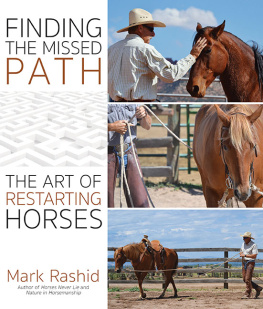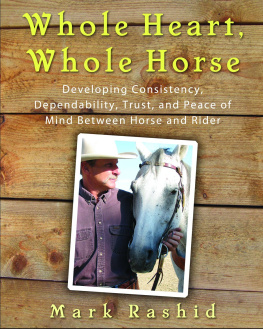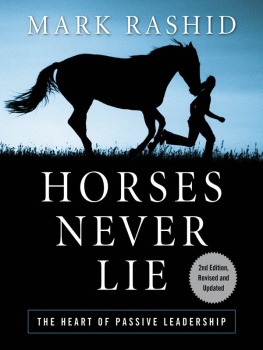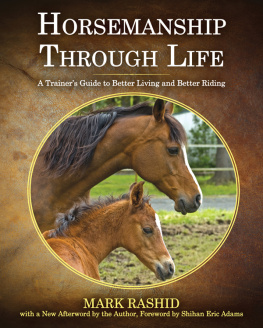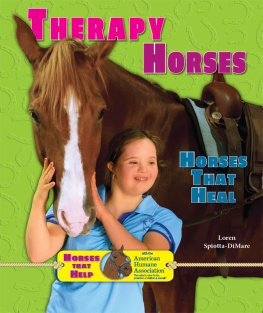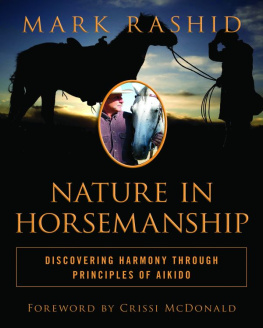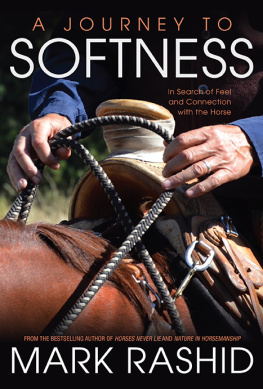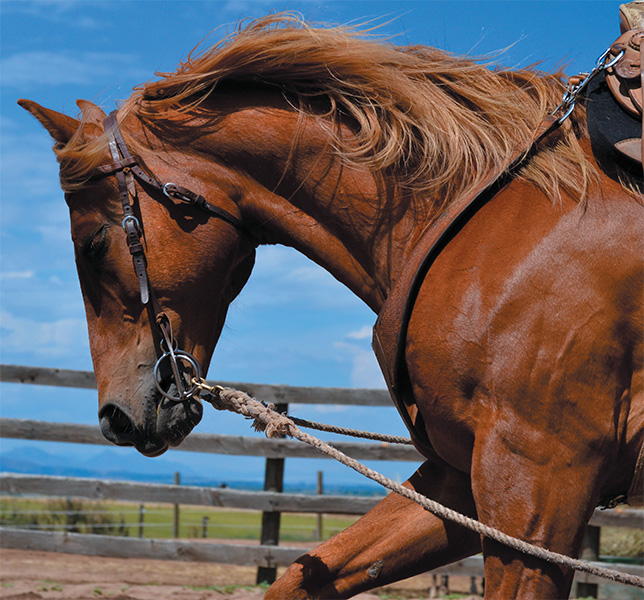First published in 2016 by
Trafalgar Square Books
North Pomfret, Vermont 05053
Copyright 2016 Mark Rashid
All rights reserved. No part of this book may be reproduced, by any means, without written permission of the publisher, except by a reviewer quoting brief excerpts for a review in a magazine, newspaper, or website.
Disclaimer of Liability
The author and publisher shall have neither liability nor responsibility to any person or entity with respect to any loss or damage caused or alleged to be caused directly or indirectly by the information contained in this book. While the book is as accurate as the author can make it, there may be errors, omissions, and inaccuracies.
Trafalgar Square Books encourages the use of approved safety helmets in all equestrian sports and activities.
Library of Congress Cataloging-in-Publication Data
Names: Rashid, Mark, author.
Title: Finding the missed path : the art of restarting horses / Mark Rashid.
Description: North Pomfret, Vermont : Trafalgar Square Books, 2016. | Includes index.
Identifiers: LCCN 2016024664 (print) | LCCN 2016033312 (ebook) | ISBN 9781570767692 (pb) | ISBN 9781570768125 (kindle) | ISBN 9781570768132 (epub)
Subjects: LCSH: HorsesTraining. | HorsesPsychology. | HorsesBehavior.
Classification: LCC SF287 .R274 2016 (print) | LCC SF287 (ebook) | DDC 636.1/0835dc23
LC record available at https://lccn.loc.gov/2016024664
Photographs by Crissi McDonald
Book design by DOQ
Cover design by RM Didier
Typefaces: Museo Slab, Bembo Std
Printed in China
10 9 8 7 6 5 4 3 2 1
Preface
F or nearly 25 years I have been extremely fortunate to be able to write books about my experiences with horses and have had folks so generously appreciate them all over the world. To this day, it amazes me that people find the things I try to share through my books not only helpful but also interesting, and I am truly grateful to have become a part of the horsemanship journey of so many.
Pretty much from the start Ive found that one of the most interesting parts of the process of book writing is coming up with the books title. One would think it would be relatively easy to come up with a title for a book, and sometimes it is, but sometimes it can also be a real struggle. Ill give you an example: With my very first book Considering the Horse: Tales of Problems Solved and Lessons Learned, the title actually came pretty easily. In fact, I actually had the title before I had the outline for the book.
However, the title I had come up with was Considering the Horse, no subtitle. The publisher insisted we add the subtitle because they felt without the subtitle, nobody would know what was in the book and so it wouldnt sell. I didnt really agree. I felt that, as someone interested in horses, just the words Considering the Horse would be enough to pique my interest and pick it up, but then, Im just a horse guy and not someone who publishes books for a living. They also werent happy with the word Considering. They didnt like the ing at the end. They felt the word Consider was more decisive than the word Considering and so wanted the title to be Consider the Horse.
I found myself having to justify the fact that, although this was my first book, it was still a representation of not just me as a person but also my overall philosophy both with horses as well as life in general. I explained that the words Consider the Horse represented a demand, as if telling people what to do, something I try never to do with people or horses, and in fact, something I never even did in the book. The words Considering the Horse, on the other hand, represented an active pursuit and way of doing things.
Believe it or not, this ended up being a month-long discussion between me and the publisher in which I finally said that if they insisted on using the word Consider instead of Considering, I would need to pull out of the deal. They finally relented and things went along pretty smoothly after that. In fact, due to the books eventual popularity I found they seemed perfectly happy to allow me to choose the titles for the next six books that we did together with little or no input from them.
Fast-forward 25 years to this book: Finding the Missed Path: The Art of Restarting Horses. Because the word restarting is in the title, one can assume, and rightfully so, that the book is going to have some specific ideas on how to work with a horse that has had some unfortunate handling in the past. While that certainly is the case, I felt this book in particular needed to be much more than just a step-by-step manual on what to do with a horse whose training has gotten off track.
For those who have read one or more of my books, you probably already know that Im not much of a step-by-step kind of guy. I really struggle with trying to read how-to books of any kind, but particularly horse books, so Im sure not going to be able to write one. Besides, when it comes to horses that are struggling so much that they may need a restart, I find it is often some kind of step-by-step training program that got them into the fix in the first place.
With that being said, I must admit that this book probably does contain more step-by-step information in it than perhaps any of my other previous books, although I did still try to present the information in as kind a way to the reader as possible. What I mean by that is while sometimes there may be a specific order to certain steps I might go through in certain situations, nothing is ever carved in stone and can be adjusted, added to, or even eliminated at any time, depending on what the horse is presenting.
Another thing I tried to do in this book is lay out some of the reasons why a horse may need to be restarted in the first place, when a restart might be needed, and when a restart may not be needed. I also included some things to consider or look for as far as outside sources that may be causing unwanted behaviorthings that ultimately may have nothing at all to do with training. There is a chapter on training tools I use, and dont use, as well as the difference in dynamics between domestic horses and feral horses, and how each of these things play into training and handling of troubled horses. Ive also added a chapter with my thoughts on the idea of respect in relation to horses and training, something I look at a little differently than perhaps some other folks do these days.
Something a little different than in any of my other books is the addition of photographs depicting the actual situations I talk about. Many of these photos are in relation to a troubled little mare named Lily who Ive taken through a complete restart from beginning to end, a process much of which Crissi and I were able to document in real time. We were also able to document the catching process of a Mustang stallion who misunderstood what it meant to allow himself to be approached and touched.
So as you will no doubt begin to see as you read Finding the Missed Path: The Art of Restarting Horses, the art of the process of restarting is not only in knowing what to do, when to do it, and why, but it is also understanding that a restart may have to occur before the horse is even under saddle, as was the case with the Mustang stallion.
I want to thank you once again for allowing me the honor and privilege of becoming part of your horsemanship journey, and as is the case with all of my books, I hope you enjoy it as much as Ive enjoyed putting it together for you.

